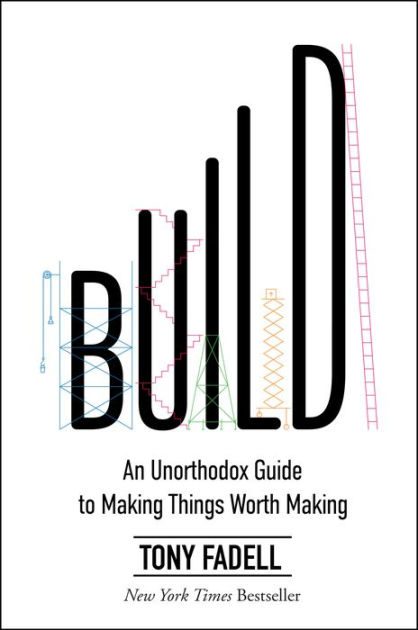In Build: An Unorthodox Guide to Making Things Worth Making, former Apple employee and co-creator of the iPhone and iPod Tony Fadell shares lessons learned, mistakes made and advice for navigating the roller coaster of creativity. He writes about starting out in business, Joining Phillips as CTO at age 25, failing with General Magic, Joining Apple as a consultant, co-creating the iPhone and iPod, Starting Nest Labs and his life in building life-changing products. Fadell calls the book “An advice encyclopedia. A mentor in a box.”
“I was incredibly lucky to lead the team that made the first eighteen generations of the iPod. Then we got another incredible opportunity—the iPhone. My team created the hardware—the metal and glass that you held in your hand—and the foundational software to run and manufacture the phone. We wrote the software for the touchscreen, the cellular modem, the cell phone, Wi-Fi, Bluetooth, etc. Then we did it again for the second-generation iPhone. And then again for the third.”
American engineer, designer and entrepreneur Tony Fadell is often referred to as the father of the iPod. He joined Apple in 2001 and served as the Senior Vice President of the iPod and iPhone division. His team was in charge of building the hardware and foundational software for the iPhone and iPod. He left Apple in 2010 to start Nest Labs with Matt Rogers in a garage in Palo Alto.
Nest Lab was acquired by Google in 2014 for $3.5 Billion. Fadell has over 300 patents to his name and was named as one of Time’s “100 Most Influential People in the World” in 2014.
Career Highlights: Lead software & Hardware Engineer at General Magic, CTO of Phillips at 25, Joined Apple in 2001 as a consultant, his team built the hardware and foundational software for the iPod and iPhone, Started Nest Labs in 2014 with Matt Rogers, Google acquired Nest for 3.2 Billion dollars.
Favourite Takeaways: Build: An Unorthodox Guide to Making Things Worth Making by Tony Fadell.
“The only failure in your twenties is inaction. The rest is trial and error.” —ANONYMOUS”
Follow your curiosity
The best way to find a job you’ll love and a career that will eventually make you successful is to follow what you’re naturally interested in, then take risks when choosing where to work. Follow your curiosity rather than a business school playbook about how to make money. Assume that for much of your twenties your choices will not work out and the companies you join or start will likely fail. Early adulthood is about watching your dreams go up in flames and learning as much as you can from the ashes. Do, fail, learn. The rest will follow.
Embrace the Struggle
The critical thing is to have a goal. To strive for something big and hard and important to you. Then every step you take toward that goal, even if it’s a stumble, moves you forward. And you can’t skip a step—you can’t just have the answers handed to you and detour around the hard stuff.
Humans learn through productive struggle, by trying it themselves and screwing up and doing it differently next time. In early adulthood you have to learn to embrace that—to know that the risks might not pan out but to take them anyway. You can get guidance and advice, you can choose a path by following someone else’s example, but you won’t really learn until you start walking down that path yourself and seeing where it takes you.
On Failure
You might screw up. Your company might fail. You might have so many butterflies in your stomach you’ll be worried you got food poisoning. And that’s okay. It’s exactly what should be happening. If you don’t feel those butterflies then you’re not doing it right. You have to push yourself up the mountain, even if it means you might fall off a cliff.
Work-Life Balance
You should never kill yourself for your job, and no job should ever expect that of you. But if you want to prove yourself, to learn as much as you can and do as much as you can, you need to put in the time. Stay late. Come in early. Work over the weekend and holidays sometimes. Don’t expect a vacation every couple of months. Let the scales tip a little on your work/life balance—let your passion for what you’re building drive you.
“If you’re not solving a real problem, you can’t start a revolution.”
Loving what you do
To do great things, to really learn, you can’t shout suggestions from the rooftop then move on while someone else does the work. You have to get your hands dirty. You have to care about every step, lovingly craft every detail. You have to be there when it falls apart so you can put it back together.
You have to actually do the job. You have to love the job.
On Management
“I didn’t become an engineer by just snapping my fingers and getting a job—I worked at it. I went to school. I practiced for years. The same process is necessary for management.”
“I started with some management classes. No class will give you all the answers, but any class is better than nothing. And then I went way beyond the basic classes you’ll take at a big company—I went down the rabbit hole. I started reading management books and realized that a great deal of management comes down to how you manage your own fears and anxieties. That led me to psychology books. And that led me to therapy. And yoga.”
Data vs Opinion
If you don’t have enough data to make a decision, you’ll need insights to inform your opinion. Insights can be key learnings about your customers or your market or your product space—something substantial that gives you an intuitive feeling for what you should do. You can also get outside input: talk to the experts and confer with your team. You won’t reach consensus, but hopefully you’ll be able to form a gut instinct. Listen to it and take responsibility for what comes next.
Storytelling
Storytelling is how you get people to take a leap of faith to do something new. It’s what all our big choices ultimately come down to—believing a story we tell ourselves or that someone else tells us. Creating a believable narrative that everyone can latch on to is critical to moving forward and making hard choices. It’s all that marketing comes down to. It’s the heart of sales.
Every product should have a story, a narrative that explains why it needs to exist and how it will solve your customer’s problems. A good product story has three elements:
- It appeals to people’s rational and emotional sides.
- It takes complicated concepts and makes them simple.
- It reminds people of the problem that’s being solved—it focuses on the “why.”
“A good story is an act of empathy. It recognizes the needs of its audience. And it blends facts and feelings so the customer gets enough of both. ”
The best ideas are painkillers, not vitamins.
Vitamin pills are good for you, but they’re not essential. You can skip your morning vitamin for a day, a month, a lifetime and never notice the difference. But you’ll notice real quick if you forget a painkiller.
Painkillers eliminate something that’s constantly bothering you. A regular irritation you can’t get rid of. And the best pain—so to speak—is one you experience in your own life. Most startups are born from people getting so frustrated with something in their daily experience that they start digging in and trying to find a solution.
“Throwing darts at a wall is not how you pick a great idea. Anything worth doing takes time. Time to understand. Time to prepare. Time to get it right. You can fast-track a lot of things and skimp on others, but you cannot cheat time.”

All the best in your quest to get better. Don’t Settle: Live with Passion.



Comments are closed.